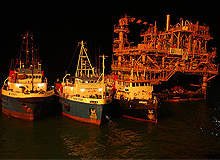
The Kharg Island gas gathering and natural gas liquids (NGL) recovery project is being developed by the Iranian Offshore Oil Company (IOOC). The project involves construction of a gas treatment plant and an NGL recovery facility at Kharg Island in Iran. The two facilities will receive and process gas from both onshore and offshore sources.
About 300MMcfg/d of gas will be gathered from offshore fields and another 300MMcfg/d from onshore processing facilities. Onshore gas will be fed from the Aboozar; Dorood I, II and III; and Foroozan oil processing facilities. Offshore gas will be gathered from the Aboozar, Bahregansar, Foroozan, Nowrooz and Soroosh fields.
The project will help in reducing flaring of 600MMcf/d-700MMcf/d of gas from these fields. It will also help Iran follow the guidelines of the Kyoto protocol to reduce flaring.
Kharg Island construction and infrastructure
The Kharg Island project is made up of five components including gas gathering and compression, a sulphur recovery unit, and LPG storage and loading. An NGL plant, acid gas removal and reinjection, a seawater system and associated utilities are also part of the project.
Offshore gas gathering will be carried out by two new gas compression platforms at Bahregansar and Aboozar fields. The Foroozan, Nowrooz and Soroosh fields will be connected to these platforms.
An offshore pipeline will also be installed to transport the compressed gas from these platforms to the NGL plant on Kharg Island.
Onshore gas from the Aboozar; Dorood I, II and III; and Foroozan processing facilities will be collected and compressed before being sent to the NGL recovery plant.
Two acid gas removal units designed by Shell Global Solutions will be built as part of the project. The units will remove sweet gas and acid gas from the compressed gas and send it to the NGL plant. The sweet gas from the acid gas removal plant will be processed by two NGL trains at the NGL plant.
The sulphur recovery unit will use Claus technology to produce 1,200t/d of sulphur. The sulphur produced will be solidified and granulated for export.
The seawater system and associated utilities of the project will include a 550m jetty, and a seawater intake and outfall cooling unit. The jetty can accommodate 80,000m³ LNG carriers.
Residual sour gas from these facilities will be reinjected into the Dhruma formation in the Dorood field 4,500m under the seabed. It will mark the first gas reinjection to take place in Iran.
Contractors
John Brown Hydrocarbons carried out the basic engineering and FEED studies for the onshore facilities of the project. The FEED study for the marine export facilities was carried out by Royal Haskoning.
The EPC contract was originally given to a consortium of Japan’s JGC Corporation and South Korea’s Daewoo Engineering and Construction in May 2004. The companies withdrew from the project in June 2004 citing rising steel and transportation costs. The IOOC later awarded the contract to the Iran International Engineering Company (IRITEC).
IRITEC subcontracted Tehran Raymand Consulting Engineers to carry out detailed design of the interconnecting area and the common utilities of various facilities of the project.
IRITEC awarded a $66.7m contract to Gulf Piping and Petrochemical Industries Design and Engineering for fabrication and installation of the gas compression platforms at Bahregansar and Aboozar. The companies will also be responsible for installing bridge links between the existing oil production platforms at the fields and the new gas compression platforms.
Siirtec Nigi was appointed the EPC contractor for acid gas removal and NGL plants.
Output
The project is expected to produce 403MMcf/d of methane, 2,196t/d of propane, 2,547b/d of pentane and 4,998b/d of condensate. It will also produce 1,253t/d of butane and 62MMcf/d of ethane. These products will be supplied as feedstock to olefin, methanol and petrochemical industries on Kharg Island.

